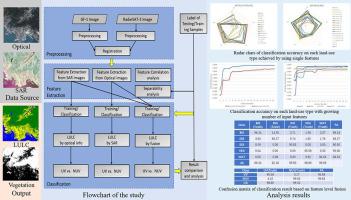International Journal of Applied Earth Observation and Geoinformation ( IF 7.5 ) Pub Date : 2021-08-21 , DOI: 10.1016/j.jag.2021.102496 Yunkun Bai 1, 2, 3 , Guangmin Sun 1 , Yu Li 1 , Peifeng Ma 4 , Gang Li 5 , Yuanzhi Zhang 6

|
Vegetation is a land-use type that attracting growing attention in urban studies. Extraction of urban vegetation information can be achieved by land-use/land-cover (LULC) classification. It has been proved that SAR remote sensing provides complementary information in LULC classification. However, how the complementary information from SAR features contribute to the classification in highly-dense urban area is still unclear. In this study, taking the highly urbanized area of Hong Kong as the study site, comprehensive studies were conducted to investigate the contribution of optical and polarimetric SAR features for LULC classification and urban vegetation extraction. Firstly, large amount of redundant information was found within optical and SAR features sets by Pearson correlation analysis. Then analysis based on J-S distance revealed that optical features have much stronger capabilities on LULC classification and some key features such as NDVI and Mean value of GLCM carry distinct information for discriminating certain land-use types. Supervised classification based on random forest further proved this result. The complementary mechanism of optical and polarimetric SAR features can be clearly observed in the radar chart. Therefore, when fusing optical and SAR features on the feature-level, the classification accuracy further improved. It was discovered that the volume scatter mechanism plays a vital role in the feature-level classification model. Finally, the overall classification accuracy of the classification model does not significantly grow after several key optical and SAR features are inputted, confirming again the high correlation between the features. In vegetation extraction, optical features provide most information and achieved the high accuracy of 99.02%. The results discovered in the above research could benefit the designing algorithms and selecting features for high accuracy urban LULC classification and vegetation extraction based on optical and SAR data.



























 京公网安备 11010802027423号
京公网安备 11010802027423号